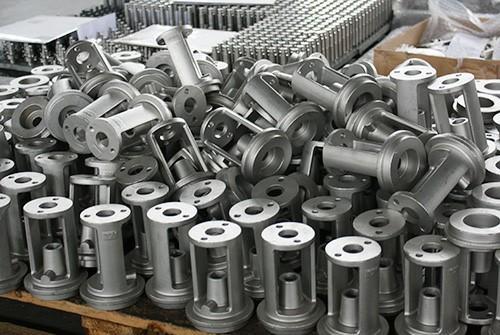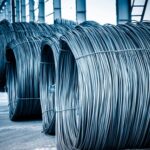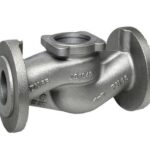Cast iron is iron or a ferrous alloy which has been heated until it liquefies, and is then poured into a mould to solidify. It is usually made from pig iron. The alloy constituents affect its colour when fractured: white cast iron has carbide impurities which allow cracks to pass straight through. Grey cast iron has graphite flakes which deflect a passing crack and initiate countless new cracks as the material breaks.
Carbon (C) and silicon (Si) are the main alloying elements, with the amount ranging from 2.1–4 wt% and 1–3 wt%, respectively. Iron alloys with less carbon content are known as steel. While this technically makes these base alloys ternary Fe–C–Si alloys, the principle of cast iron solidification is understood from the binary iron–carbon phase diagram. Since the compositions of most cast irons are around the eutectic point of the iron–carbon system, the melting temperatures closely correlate, usually ranging from 1,150 to 1,200 °C (2,100 to 2,190 °F), which is about 300 °C (572 °F) lower than the melting point of pure iron.
Cast iron’s properties are changed by adding various alloying elements, or alloyants. Next to carbon, silicon is the most important alloying because it forces carbon out of solution. Instead the carbon forms graphite which results in a softer iron, reduces shrinkage, lowers strength, and decreases density. Sulfur, when present, forms iron sulfide, which prevents the formation of graphite and increases hardness. The problem with sulfur is that it makes molten cast iron sluggish, which causes short run defects. To counter the effects of sulfur, manganese is added because the two form into manganese sulfide instead of iron sulfide. The manganese sulfide is lighter than the melt so it tends to float out of the melt and into the slag. The amount of manganese required to neutralize sulfur is 1.7 × sulfur content + 0.3%. If more than this amount of manganese is added, then manganese carbide forms, which increases hardness and chilling, except in grey iron, where up to 1% of manganese increases strength and density.
Nickel is one of the most common alloying elements because it refines the pearlite and graphite structure, improves toughness, and evens out hardness differences between section thicknesses. Chromium is added in small amounts to the ladle to reduce free graphite, produce chill, and because it is a powerful carbide stabilizer; nickel is often added in conjunction. A small amount of tin can is added as a substitute for 0.5% chromium. Copper is added in the ladle or in the furnace, on the order of 0.5–2.5%, to decrease chill, refine graphite, and increase fluidity. Molybdenum is added on the order of 0.3–1% to increase chill and refine the graphite and pearlite structure; it is often added in conjunction with nickel, copper, and chromium to form high strength irons. Titanium is added as a degasser and deoxidizer, but it also increases fluidity.
0.15–0.5% vanadium is added to cast iron to stabilize cementite, increase hardness, and increase resistance to wear and heat. 0.1–0.3% zirconium helps to form graphite, deoxidize, and increase fluidity.
In malleable iron melts, bismuth is added, on the scale of 0.002–0.01%, to increase how much silicon can be added. In white iron, boron is added to aid in the production of malleable iron; it also reduces the coarsening effect of bismuth.


